Authentic Pfeffernüsse
This post may contain affiliate links. See my disclosure policy.
One of Germany’s most popular and beloved Christmas treats, these spiced and iced cookies known as Pfeffernüsse are simply delightful! A thoroughly authentic and incredibly delicious homemade Pfeffernusse recipe that will bring back fond memories or help create new holiday traditions!
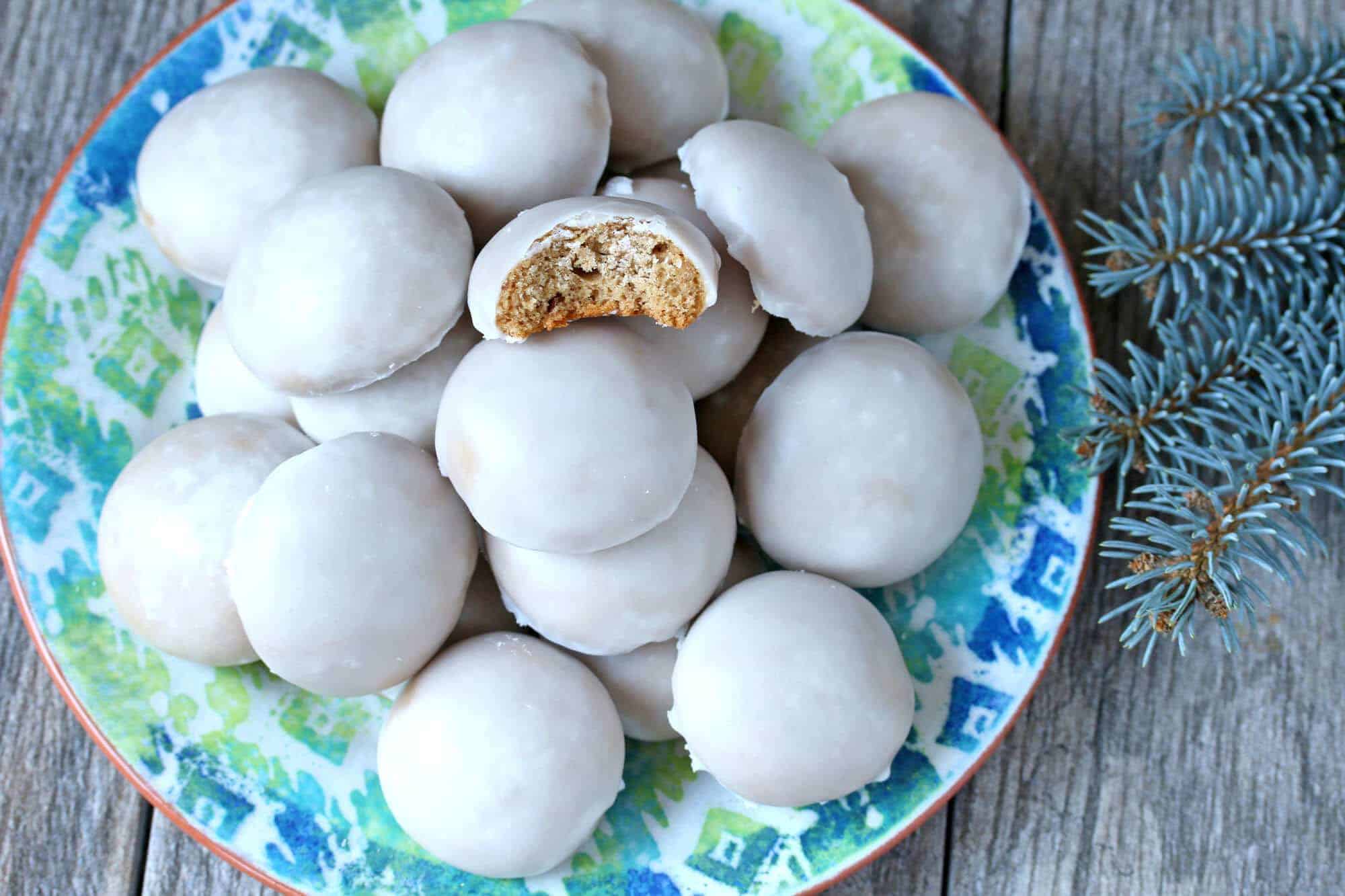
What Are Pfeffernüsse?
The Netherlands and Germany enjoy a similar cookie in the month of December. Known as Pepernoten in the Netherlands, they are eaten in celebration of the arrival of Sinterklaas on December 5. In Germany they are known as Pfeffernüsse and although St. Nicholas comes on December 6, Pfeffernüsse are enjoyed throughout the entire Christmas season.
The coming of the jolly bearded man so early on in the month will sound confusing to those who await Santa on December 25. But in Germany, and many other European countries, the tradition is that St. Nicholas visits the kids earlier in December. Traditionally shoes are left in front of the door and if you’re good they’ll be filled with oranges and nuts – if you’re bad, you’ll get shoes full of coal. Then, on Christmas Eve, it’s not Santa who comes to the home to deliver gifts, it’s the Christkind – the Christ child, the ultimate Giver – who gives the gifts.
Pepernoten and Pfeffernüsse are both spice/gingerbread-like cookies and have some similarities, but the ingredients vary as does the method of preparation. Also, Pfeffernuesse are commonly coated with a sugar icing. The name Pfeffernuesse means “pepper nuts.” The pepper part refers to the white pepper that is added to the dough which gives these cookies a very unique and flavorful touch. The nuts part refers to their walnut-like shape.
In Germany you can find Pfeffernusse in any grocery store throughout the holidays. I have to admit, as popular as they are I’ve never cared for store-bought Pfeffernusse. And so if you were to tell me you don’t like them either I would understand. BUT…homemade is a totally different story. Everything about homemade Pfeffernusse is better – the flavor, the texture. In short, if like me you don’t like the store-bought stuff, give these a try – I think these German spice cookies will win you over!
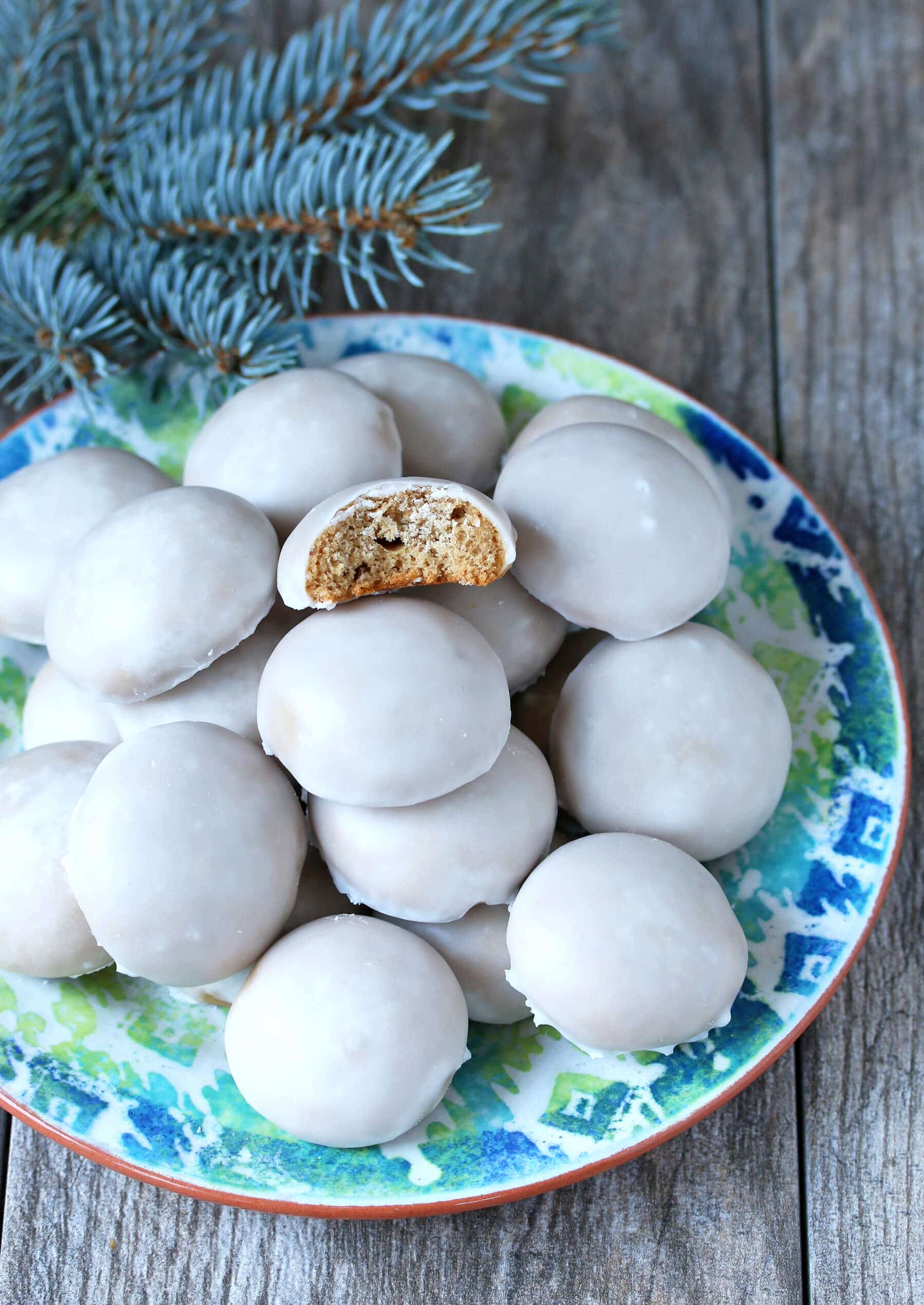
Pfeffernüsse Recipe
Let’s get started!
In a small bowl, combine the flour, baking soda, salt, Lebkuchengewürz, white pepper and almond meal. Set aside.
Combine the brown sugar, honey, butter, and cream in a medium saucepan and heat, stirring frequently, until melted and the sugar is dissolved.

Remove from heat and let sit 5 minutes. (Note: While not traditionally included, for some added flavor and texture you can also stir in some finely chopped Candied Orange Peel or Candied Ginger.)
Stir in the flour mixture.

Stir in the egg until thoroughly combined.
The dough will have a nice glossy sheen. The dough will be very sticky and that’s how it should be.

Turn the mixture out onto some plastic wrap and wrap the dough tightly. Refrigerate at a minimum overnight to allow the flavors time to develop, or for up to two days.
Remove the dough from the plastic wrap and immediately roll it into two strands, each 3/4 inch thick. Slice the rolls into 3/4 inch thick rounds.
Roll each round into a ball (each ball should be about 3/4 inch large). Work quickly while the dough is still chilled.

Place the cookie balls on a line cookie sheet and bake for 15 minutes or until golden brown.
Remove and let the cookies cool a few minutes before transferring them to a wire wrack to cool completely.

To make the glaze, combine the powdered sugar and water until smooth.
Dip each cookie in the glaze, letting the excess drip off, and place them on a wire rack positioned over a cookie sheet (to catch the drips).

Repeat for all of the cookies and let the Pfeffernusse sit until the glaze is fully hardened.
Store the cookies in airtight container in a cool place.
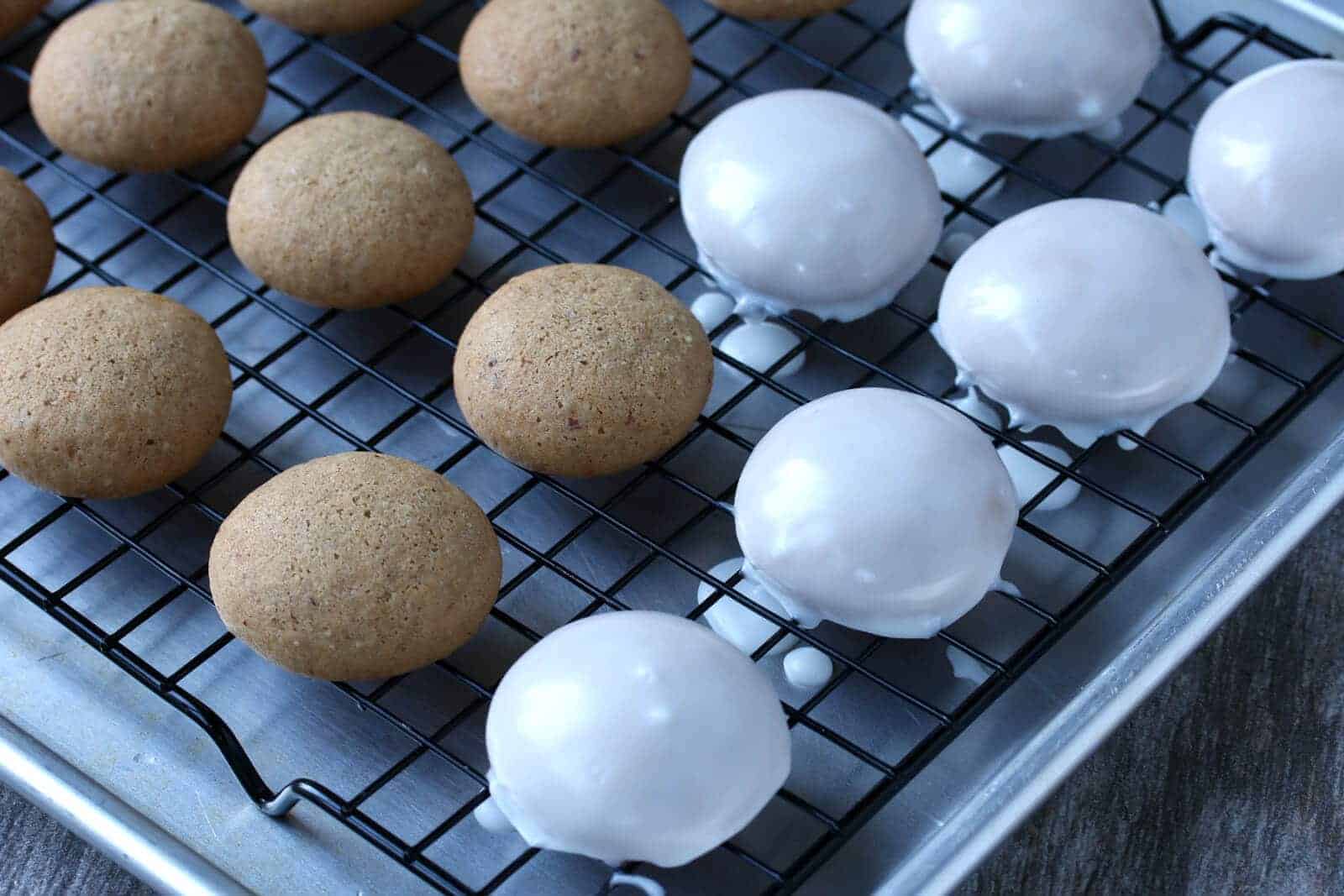
Pfeffernusse will keep for at least 2 weeks and the flavor only gets better over time. Enjoy them on their own or dunked in your favorite hot beverage.
And be sure to check out all of my favorite traditional German Christmas Cookies!
Enjoy!
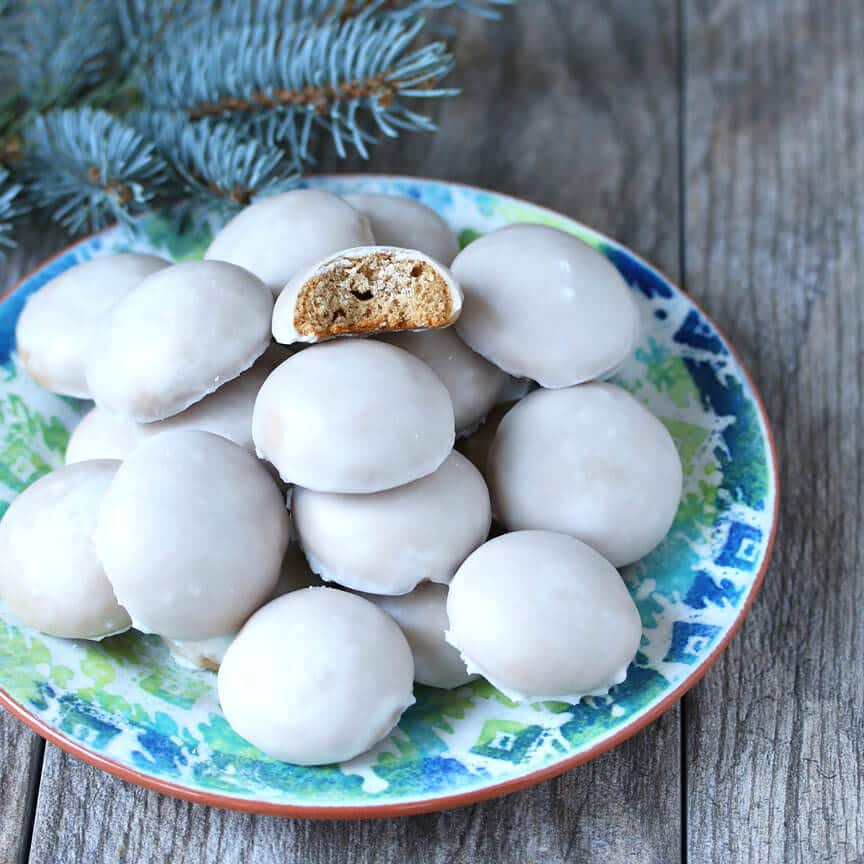
For more authentic German Christmas recipes try my:
- Stollen
- Lebkuchen
- Engelsaugen
- Marzipan
- Springerle
- Gugelhupf
- Dampfnudel
- Berliner Brot
- German Rum Balls
- Printen
- Speculoos
- Vanillekipferl
- Zimtsterne
- Bethmännchen
- Heidesand
- Kokosmakronen
Save This Recipe
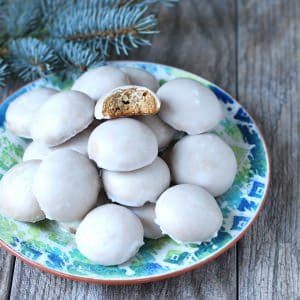
Authentic Pfeffernüsse
Equipment
Ingredients
- 2 1/4 cup all-purpose flour
- 1/2 teaspoon baking soda
- 1/4 teaspoon salt
- 3-4 teaspoons Lebkuchengewürz
- Homemade Lebkuchengewürz (STRONGLY recommended for best flavor), click link for recipe
- 1/4 teaspoon finely ground white pepper
- 1/4 cup almond meal or almond flour (meal has skins intact, flour has skins removed; more aesthetics than anything)
- 1/2 cup packed brown sugar
- 1/3 cup pure honey
- 5 tablespoons unsalted butter
- 3 tablespoons heavy cream
- 1 large egg
- For the Glaze:
- 2 1/2 cups powdered sugar
- 3-4 tablespoons hot water (less water will result in a thicker & whiter glaze)
Instructions
- In a small bowl, combine the flour, baking soda, salt, Lebkuchengewuerz, white pepper and almond meal. Set aside.
- Combine the brown sugar, honey, butter, and cream in a medium saucepan and heat, stirring frequently, until melted and the sugar is dissolved. Remove from heat and let sit 5 minutes. Stir in the flour mixture. Once incorporated stir in the egg until thoroughly combined. The dough will have a nice glossy sheen. It will be very sticky and that’s how it should be.
- Turn the mixture out onto some plastic wrap and wrap the dough tightly. Refrigerate overnight or for up to two days.
- Preheat the oven to 350 degrees.
- Remove the dough from the plastic wrap and immediately roll it into two strands, each 3/4 inch thick. Slice the rolls into 3/4 inch thick rounds and roll each round into a ball (each ball should be about 3/4 inch large). Work quickly while the dough is still chilled. Note: The size is just personal preference, you can make them larger if you prefer.Place the cookie balls on a line cookie sheet and bake for about 15 minutes or until golden brown. Remove and let the cookies cool completely.
- To make the glaze, combine the powdered sugar and water until smooth.Dip each cookie in the glaze, letting the excess drip off, and place them on a wire rack positioned over a cookie sheet (to catch the drips) and let them sit until the glaze is fully hardened.Store the cookies in airtight container in a cool place. Will keep for at least 2 weeks (they're usually stored longer) and the flavor only gets better over time.Makes 50+ cookies depending on their size.
Nutrition
Originally published on The Daring Gourmet December 20, 2015



















I followed the recipe exactly but my pferrnusse came out rather flat rather than round. What did I do wrong?
This happens for a few reasons. One is over mixing. Another thing you can try is letting the egg get to room temp.
I hope this helps.
Dee :)
If I have lebkuchengewurz left over after my lebkuchen-spree, I’ll try this one this year! I love that you share these authentic recipes and I have not been disappointed with one yet! Thank you so much for sharing them :)
Thank you, Kaylyn, I really appreciate that! :)
Love this recipe. I too never enjoyed the store bought ones. my grandmother used to send bags from Germany when I was a child. This tastes so much better. I have been developing a Rum-Pfefferkuchen recipe, similar flavor profile to the cookies. My mom has been making it for years, but I have changed it for my daughters, so they don’t need the hirschorn saltz. Thanks for a great job on your site!
Thank you so much, Rose, I’m happy you enjoyed them!
Love the cookies 🙂. For the icing I used 250 gram of sifted powdered sugar, 1 TBLS of hot water and 2 TBLS of orange juice.
I think I’ll use this recipe for making my Sossenkuchen next year for the Silesian Christmas Sauce / dinner, with slight variations:
Instead of all purpose flour, I’ll use rye flour and leave the white pepper out.
Thanks so much, Daniel, I’m happy you enjoyed them! My Oma and Opa were from Silesia, from Breslau. Enjoy the Soßenkuchen!
Hello Kimberly,
My Dad was born and raised in Breslau before the war.
He made the Pfefferkuchensosse every Christmas with potatoes, sauerkraut and special ordered white and red sausages, and smoked meat.
I carry on that tradition and even though you can’t find the special made sausages here in the US, I found a German butcher store that offers similar sausages 🙂
That’s really neat that you carry on those precious traditions, Daniel. My Oma was born and raised in Breslau and met and married my Opa there. I visited Breslau with both of them before they passed away, taking video footage of all the sites they knew and loved, the school they attended, the place where my Opa proposed to my Oma, the apartment they lived in, etc, and am so happy I was able to capture those memories and interviews on video for posterity. During WWII they were forced onto a train with nothing but the clothes on their backs, their families scattered in every direction throughout Germany, and my Oma and Opa were dropped off in Bavaria. Breslau was a truly stunning city with many bridges and beautiful architecture. The town square is magnificent.
I never went to Breslau, though my parents went, after the Iron Curtain fell. After WWII, and after being released from a US POW camp, my dad ended up in North Rhine-Westphalia, his family scattered all over Germany as well.
This recipe saved our Silesian Christmas Dinner: I had made Sossenkuchen, using a different recipe, but when the time came to make the Pfefferkuchensosse, the Sossenkuchen had a funky taste and smell to it.
This recipe to the rescue: I whipped up the batter really quick (minus the extra white pepper), poured it into a round cake pan and baked it in my Anova Precision Oven. Let it cool, then sliced and diced it into cubes, pouring over Malt Beer to soften and then mixed it together with the pureed vegetables and broth.
This was awesome!!!
Thank you again for this great recipe 🙂
That’s terrific, Daniel, thank you and I’m so glad you enjoyed it! :)
Hello, if I wanted to make them have a chewier texture what should I do? Just egg yolk instead of the whole egg, more honey, more brown sugar, refrigerate for more than a day? etc.
Hi James, Pfeffernüsse aren’t chewy cookies and to make them such would basically mean altering the entire recipe which would render them something other than Pfeffernüsse.
You may like lebkuchen more! They are softer, flat and still have the lebkuchgewurz and almond flour (meal, actually.) no white pepper, but who is to stop you? Happy baking!
Hi! I first found these cookies when the grocery store I worked at sold them and I loved them. Last year, I couldn’t find them anywhere and went looking for recipes. I’m really excited to try this, but I’m curious if they will be a crunchy cookie or a soft texture? I love a softer cookie and just want to know what to expect. Thanks!!
Hi Kristin, these are not crunchy at all, the texture is very much like the store-bought ones.
I made some tweaks to make them more authentically German (like the leavening agents instead of baking soda and using part treacle and part honey to mimic the Zuckerruebensyrup as the honey alone just doesn’t do it) but I’ve never seen pfeffernüsse made with almonds before both in Germany and out. It’s one of the few that is but free despite its name.
I’m curious as to where the addition came from?
Hi Marie, if your aim is to make these authentic German in the “traditional” sense then you’ll want to stick with both the honey and the inclusion of nuts. The oldest German recipes used honey because Zuckerrübensirup didn’t even come along until the 20th century. Zuckerrübensirup (a sugar syrup made from sugar beets) came about as a factory byproduct and didn’t really take off until the 1950’s. It became widespread around the 1970’s. Like Karo Syrup here in the U.S., Zuckerrübensirup became a cheaper substitute for honey and so while you will find it called for in “modern” German recipes for Pfeffernüsse (mid 20th century and newer) you will not find it in older, traditional German recipes. Likewise the inclusion of nuts are very traditional in the oldest recipes.
Hi! My family LOVES these cookies, so I am so excited to try your recipe this year! However, we have a nut intolerance in the family and I’d like to know what you’d recommend as a substitute for almond flour? Thanks for all of the amazing recipes :-)
Hi Maren, you can substitute 3 tablespoons of regular flour. Happy baking!